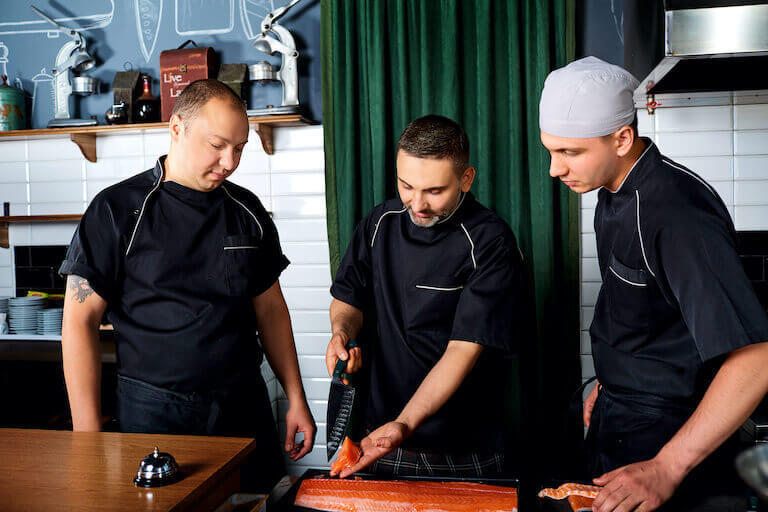Listen to This Article:
Restaurant management is all about ensuring customers have a great experience, but that doesn’t mean the job is all about customer service. Instead, this role involves a lot of back office responsibilities, like cost control, managing contracts, marketing, and hiring and firing, in addition to hands-on operations management to ensure your front-of-house and back-of-house are operating smoothly.
It’s a dynamic and fast-paced position that can require long hours, people skills, and attention to detail—and, for the right person, it can be hugely satisfying to see all these moving parts come together to create a dining experience that customers love.
This article will cover some of the key responsibilities involved in this role, their importance, and strategies for tackling them, along with laying out the traits that make a good manager and the paths one can take to land this exciting position.
The responsibilities of a restaurant manager fall into two broad categories—administrative responsibilities and operational responsibilities. Because of the dynamic nature of the job, there can be a lot of overlap between these two. For example, a business decision involving controlling payroll costs may also require retraining existing staff, while a marketing decision involving a special promotion may require coordination with the kitchen to ensure it’s carried out as advertised. This complexity is all part of the job.
With the understanding that each of the following duties will have some implications that affect the others, here’s an overview of some of the chief responsibilities involved in restaurant management, and some strategies for tackling them.
Hiring and Managing Staff: Prioritizing Your People
Restaurants are fast-paced, intense environments where a host of people need to work together to get things done right—and at the right time—in order to deliver a great experience for customers. This is much more likely to happen in an environment that is respectful, supportive, and fair; creating such an environment is one of a restaurant manager’s most important responsibilities, and it should be at the forefront of your mind as you’re hiring and managing staff.

Creating a positive work environment can lead to happier staff and better service for your customers.
There are many things a manager can do to make sure their restaurant is a great place to work. Topics such as employee wages and tip policies are important and usually a good place to start crafting your managerial approach. Being flexible with scheduling and accommodating employee time-off requests is another.
Ensure that working conditions are safe for everyone—in terms of the physical space, and interpersonally as well. Invest the time and effort into making sure your employees are properly trained to handle their work. Recognize people for doing good work and, when it’s necessary to discipline someone, do so in a way that is both constructive and discreet.
In short, it all comes down to listening to employees and working with them to create an environment that people actually want to work in.
Customer Service: Give Them a Reason to Come Back
Restaurant management is all about creating a dining experience that customers will love. While all the planning and preparation you do in other aspects of the job will likely affect the customer experience, it’s important that you’re also present on the floor during service in order to interact with guests and make sure all your planning comes together.
During service, circulate through the dining room and make yourself available to customers. Not only can this make them feel welcome, but you’ll also be there to field complaints, which may enable you to resolve potential issues in real-time. Being present also allows you to support staff and step in wherever necessary to keep things running smoothly; in order to help your staff handle their rushes, be prepared to jump behind the bar to make drinks, or head into the kitchen to expedite plates.

A good restaurant manager can be a friendly, welcoming presence in the dining room.
Beyond that, simply being on the floor enables you to notice things about the environment that you wouldn’t be able to learn otherwise. Is the linen clean? Is the dining area bright enough? Is the compressor behind the bar too noisy? Details like this contribute to a diner’s experience, and it’s up to the restaurant manager to go out of their way to notice them.
The ultimate goal of a restaurant manager is to give customers a reason to come back, and ensuring they have a great experience is the best way to achieve that.
Food Safety and Hygiene: Sanitation Is Paramount
Not only is it irresponsible to disregard food safety and hygiene standards when serving food to your guests, but failure to comply with these standards can be a matter of existential significance for your restaurant. Violations can potentially lead to fines and closures, lawsuits, or serious damage to your reputation. For this reason, it’s important to ensure that your staff is adequately trained in proper food handling.

A restaurant is responsible for ensuring back-of-house staff complies with food safety standards.
Fortunately, these standards have been codified by various governing bodies responsible for ensuring food safety. Familiarize yourself with these standards as you go about implementing your restaurant’s policies. In the US, the FDA’s Food Code is the source for best practices in the food service industry. Your local or county board of health will likely also have its own set of standards which must be met in order to obtain the permits necessary to operate.
Generally speaking, these standards govern everything that factors into the storage and preparation of food: when and how employees must wash their hands, how various types of food must be labeled and stored, proper cooking temperatures for various foods, how to handle injuries in the kitchen, and so on.
Because kitchens are fast-paced environments, speed is important, but never more important than sanitation. It’s up to you to create written documentation of these policies for your staff to follow. Create pre- and post-shift checklists that you or others can walk through, in addition to written training protocols to ensure your staff is properly exposed to the appropriate food safety and hygiene standards.
Financial Management: Running a Profitable Business
Restaurant profit margins can be slim depending on the concept and operational costs, and the success or failure of a business depends at least as much, if not more, on a manager’s ability to control costs as it does the quality of the food.
Restaurant costs are made up of food costs and labor costs. These costs are distinct from expenses like rent, utilities, insurance, permitting, new equipment, and so on—longer-term expenses that tend to stay more or less fixed over time.
Costs, on the other hand, are more elastic, which means that they can be controlled over a shorter time frame; it is the responsibility of the restaurant manager to do exactly this. Food costs consist of the direct costs associated with the food and beverages offered in a restaurant. This includes not only the food and drink itself, but also physical items like to-go containers, straws, napkins, and ice—anything that is expended during service.
Labor costs consist of all costs associated with payroll—so not only salaries and hourly wages, but payroll taxes, overtime, paid time off, bonuses, insurance, and other benefits.

A restaurant manager must control food and labor costs to ensure that their restaurant is profitable.
Both food and labor costs are measured as a percentage of sales. By tracking this data, you will be able to forecast future costs and sales. These insights guide many of the important decisions you will have to make, from inventory management and contracts with distributors to hiring and scheduling practices. The far-reaching implications of cost control are why it is such an essential part of this job.
Of course, costs are only one side of the equation. As a manager, you can also control costs by increasing sales. There are a variety of ways you can make this happen, such as training staff to upsell, running promotions like happy hours or seasonal specials, and creating effective marketing campaigns.
Financial management isn’t about cutting costs to the bare minimum. It’s about spending money wisely in order to grow your restaurant.
Advice from Industry Leaders on “The Ultimate Dish” Podcast
Leaders of the hospitality industry tell their stories and share their wisdom with Kirk Bachmann, President of Auguste Escoffier School of Culinary Arts in Boulder.
- “Breaking Bread” – The Secret to an Immersive Restaurant Experience
- How to Reach a Big Culinary Career Goal with Erik Niel
- Award-Winning Chef Charles Carroll on Managing a Country Club Kitchen
- Emmy Award-Winning Innovator David Irons Talks Food Menus and Big Data
- Coming to America: My Father’s Pursuit of Pride, Happiness, And Hospitality
- Pastry Arts Magazine Owner Shawn Wenner Talks Food Entrepreneurship and Team Building
Inventory Management: Preventing Spoilage, Spillage, and Shrinkage
One of the most important tools in managing your restaurant’s finances is sound inventory management. Having accurate insight into your inventory could allow you to cut down on unnecessary food costs, and to get the most out of the money you are spending. There are three basic factors that play a role in inventory management: spoilage, spillage, and shrinkage.
Spoilage refers to perishable products that go bad in storage. This could result from a number of things, including overordering, not rotating stock, or faulty equipment, like a broken freezer. Reducing spoilage starts with keeping accurate inventory of your product and only ordering enough stock to keep up with par—the amount of product necessary to meet your forecasted needs.
Beyond that, ensure your staff is adequately trained in proper food handling and storage practices. You should also conduct regular inspections of your storage equipment and perform timely maintenance to ensure that small issues don’t lead to bigger problems down the road.

Tracking your inventory is a key aspect of controlling food and beverage costs.
Spillage, on the other hand, refers to perishable products that could have been used, but were wasted due to human error. This results from food and drinks that are prepared improperly, or product that has been spilled, dropped, or otherwise contaminated after preparation has begun.
Preventing spillage mostly comes down to how well your staff is trained—in food and drink preparation, in listening closely to and accurately communicating customer orders, and in techniques like carrying a tray full of drinks or balancing multiple plates.
Shrinkage refers to the diminishment of inventory that can’t be accounted for by sales, spoilage, or spillage. It happens when spoilage or spillage occurs, but isn’t tracked in the proper way. Theft can also be another common cause of shrinkage. Once again, training is an effective way to reduce shrinkage. If staff are properly trained in tracking wasted product, there will be less uncertainty as to where your inventory is going.

Proper training in how to track inventory can help reduce shrinkage.
Because a portion of shrinkage may be due to theft, security cameras can be an effective deterrent. Additional strategies for preventing theft may include ensuring that storage areas are locked, tip jars are out of reach, and guests are not overserved with alcohol.
All inventory management strategies depend on having an accurate, up-to-date inventory of your current stock, so be sure to take inventory on at least a monthly, if not a weekly basis. New tech tools can speed up or even automate some aspects of this process, helping you save time while staying on top of your inventory.
Marketing and Promotion: Getting the Word Out
As a restaurant manager, you may be responsible for handling some or all of your restaurant’s marketing and promotion efforts. While larger operations may employ dedicated marketing teams, you’re still likely to be involved in marketing decisions; for businesses that don’t have a dedicated marketing team, these duties will almost certainly fall on your shoulders.

Creative use of social media can help generate organic interest in your restaurant.
First and foremost, it’s important that you know what you’re marketing, and that you’re marketing it consistently. Put in the time to develop your restaurant’s brand identity; you may wish to hire a branding professional to help you refine the language and visual elements that you’ll use to position your restaurant and create effective marketing materials.
Beyond that, a significant portion of your marketing activity will have to do with managing your restaurant’s online presence. This will include creating and actively managing social media accounts, specifically Instagram and Facebook; making sure your website is easy to use, has an up-to-date menu, and follows SEO best practices; getting listed on review platforms like Yelp and Tripadvisor, and managing customer reviews; and developing an email outreach strategy to connect with previous customers.
In addition to that, you may also want to explore traditional marketing strategies, like print, radio, and television advertising, branded apparel, or coasters and matchbooks featuring your restaurant’s logo.
Get creative with promotions, too; happy hour discounts, seasonal promotions, live entertainment and special events, and special rewards for loyalty customers can all help drive engagement and keep people coming back to your restaurant.
Other Challenges Restaurant Managers Face
In addition to these major responsibilities, being a restaurant manager involves countless other considerations, including the following.
Reducing Employee Turnover
The restaurant industry is known for having a high employee turnover rate. Younger, more seasonal employees may be looking for a temporary job rather than a career, while more career-oriented staff often feel their opportunities for advancement are greater by switching employers rather than working their way up at one restaurant. Turnover is costly, both in terms of the time and money spent hiring and training replacements, and in terms of the drag put on your restaurant’s growth every time you lose a skilled, trained employee.
Take it upon yourself to reduce turnover by offering attractive compensation, benefits like health insurance and PTO, continuing education programs, opportunities for career advancement, and a supportive, positive work environment. These things all involve some degree of cost and effort, but nurturing a happy, motivated staff is an important investment in your business.

Restaurant managers may retain staff by creating a positive, engaging environment.
Delegating Responsibilities
As a restaurant manager, there are many things that fall within your scope of responsibility. But just because all these things need your attention, that’s not to say that you need to handle them all on your own. Delegating responsibility is a key part of leadership. Whether you’re delegating tasks to assistant managers or to employees you trust, you’ll be contributing to the effective operation of your restaurant.
Delegating responsibility can also be a great way to help with employee retention, as it gives employees a more meaningful connection with their workplace and can prepare them to step into leadership roles later on down the road.
Continuously Curating Your Menu
Your menu isn’t just a list of the food and beverages you serve—it’s an asset that can help you to grow your business and define your brand. Sit down regularly with your restaurant’s executive chef to assess your menu offerings, look for opportunities to either revise or eliminate unprofitable dishes, and talk about promotional, seasonal, or permanent changes.

A restaurant manager should work with their head chef to improve their restaurant’s menu.
Also consider ways that the menu design itself could be improved. Is it visually pleasing and accessible? Is it too long? Is anything on it outdated or inaccurate? Your menu goes a long way toward setting a diner’s expectations for their experience at your restaurant—be sure it’s making a great impression.
The Qualities of a Great Restaurant Manager
A role with such varied responsibilities requires a person with a specific skill set, which may include the following qualities.
A Genuine Love of Service
The restaurant industry is all about making people happy, and a good restaurant manager will thrive on doing so. Whether they’re greeting diners at their tables, listening to complaints and up-leveling service, or jumping behind the bar to help make drinks during a rush, a good manager is excited about doing whatever it takes to make their customers’ experience a great one. Even if they’re not on the floor every day, they should always be thinking of ways to improve service and make the customer experience even better.

Making people happy is at the core of restaurant management.
Teamwork and Communication
Despite being in a management position, a good restaurant manager will realize that they’re as much a part of the team as everyone else, and will focus on doing everything in their power to help that team function at the highest level. They should be the type of person who can lead by example, support others, mediate conflicts, and foster a sense of camaraderie and belonging. They must also be great communicators. Restaurants are fast-paced environments where communication in the moment is sometimes difficult, so they should both be able to communicate policy and expectations clearly ahead of time, and to communicate effectively on the fly.
Vision and Perspective
Because restaurants are such busy environments, it can be easy to get caught up in the day-to-day operations; on any given day there will be orders to make and receive, inventory to manage, staff to train, payroll to run, budgets to adjust, customers to please… A good restaurant manager will be able to look beyond the daily grind and see the big picture, keeping track of the business’ broader resturant managment goals and whether they’re on course to meet them. They should also have the vision to come up with exciting promotions, new menu ideas, and other creative strategies that can help the business grow and thrive.
Pathways to Becoming a Restaurant Manager
Because there are so many responsibilities involved in this position, it’s common for restaurants to require substantial prior experience for prospective restaurant managers. That said, not all paths to management look the same. If you’re looking to land a position as a restaurant manager, you may want to try one of these strategies.
1. Enroll in Formal Education in Hospitality Management
To pursue a career in restaurant management and especially hotel restaurant management, consider a degree in Hospitality and Restaurant Operations Management. Such training can be extremely valuable (and desirable to potential employers) because it can give you exposure to all aspects of this role, along with up-to-date industry best practices. With a degree in hospitality or restaurant management, you may stand out to prospective employers on account of having demonstrated a commitment to leadership in the industry. Even after a degree, though, real-world experience counts—it’s estimated that 90 percent of restaurant managers started out in entry-level positions.
2. Acquire Real-World Experience Working in the Industry
You may want to first seek out hands-on experience in the restaurant industry, in either (or both) the front or back of the house. Such hands-on experience is valuable both in that it can demonstrate that you have a deep understanding of how the various aspects of a restaurant function, and also can indicate that you’ll have empathy for the staff working in those positions. Both of these attributes can serve you well as a restaurant manager.

A combination of experience and formal training can help you stand out to prospective employers.
3. Start Your Own Restaurant or Food Business
A third path could potentially be to start your own restaurant. If you have some combination of real-world experience and formal education, along with the ambition to run your own business, you may wish to start your own restaurant rather than looking for restaurant management opportunities at existing businesses. Running a business is a challenge, so this particular path could prove to be unpredictable—as well as exciting and fulfilling for a motivated and entrepreneurial individual.
Take the Next Step to a Restaurant Management Career with a Relevant Degree
Restaurants are dynamic, fast-paced environments where many factors need to come together in just the right way in order to create an experience customers will be excited to tell their friends about. For a person with the right skill set and temperament, being a restaurant manager can be a thrilling career, and a rewarding opportunity to make people happy with food.
Getting a degree in Hospitality Management & Restaurant Operations can help an aspiring restaurant manager stand out from the competition by demonstrating a thorough understanding of the business aspects of managing a restaurant.
Plus, financial aid, grants, and scholarships are available to those who apply and qualify, which can help make the opportunity to get an education that much more accessible.
READY TO LEARN MORE ABOUT OPPORTUNITIES IN THE HOSPITALITY INDUSTRY? CHECK OUT THESE ARTICLES NEXT!
- Is Hospitality Management a Good Career Choice For You?
- Culinary School vs. Working in a Kitchen: Which Should You Do First?
- What Training Do You Need for a Career in the Hospitality Industry?





